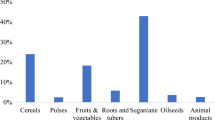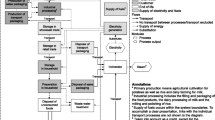Abstract
Purpose
The objective was to assess the environmental burden of food consumption and food losses in Germany with the aim to define measures to reduce environmentally relevant food losses. To support the finding of measurements, the study provides differentiated information on life phases (agriculture, processing, retailer, and consumption), consumption places (in-house and out-of-home), and the average German food basket consisting of eight food categories.
Methods
In order to obtain information on the environmental impacts of German food consumption, the study analyzed the material flows of the food products in the German food basket starting from consumption phase and going backwards until agricultural production. The analysis includes all relevant impact categories such as GWP, freshwater and marine eutrophication, particular matter formation, and agricultural land and water use. The life stages consumers, retail, wholesale, food production, and agriculture have been taken into account. Furthermore, transports to and within Germany have been considered. Consumption and production data have been taken from the German income and consumption sample, German production and trade statistics, and studies recently carried out on food losses. In order to model German food consumption, some simplifications had to be done.
Results and discussion
Results show that German food consumption is responsible for 2.7 t of greenhouse gases per person and year. Fourteen cubic meters of blue water is used for agricultural food production per person, and 2673 m2 of agricultural land is occupied each year per German for food consumption. Between 14 and 20 % of the environmental burdens (depending on the impact category) result from food losses along the value chain. Out-of-home consumption is responsible for 8 to 28 % of the total environmental impacts (depending on the impact category). In particular, animal products cause high environmental burdens. Regarding life cycle phases, agriculture and consumption cause the highest impacts: together, they are responsible for more than 87 % of the total environmental burdens.
Conclusions
The study shows that food production and consumption as well as food losses along the value chain are of high relevance regarding Germany’s environmental impacts. In particular, animal products are responsible for high environmental burdens. Thus, with respect to reducing environmentally relevant food losses, measures should focus in particular on the reduction of food waste of animal origin. The most relevant life cycle phases to reduce environmental impacts are agricultural production and consumption in households and out-of-home.





Similar content being viewed by others
Notes
http://www.fao.org/mdg/goalone/en/; status: 8 August 2012
This was done for the reason that the characteristics “avoidable” or “unavoidable” are closely correlated with a value system that can change in the course of time and in households or restaurants that also depend on the preparation and the product. Thus, potato skins could be avoided as food loss when preparing boiled potatoes in their jacket and could not be avoided if preparing boiled potatoes.
Modeling and the calculation itself were done with the software Umberto NXT LCA.
The remaining 20 % have been allocated to mother cow meat but have not been considered further in the model.
The authors used the Environmentally Extended Input-Ouput Analysis underpinned with LCI data (Jungbluth et al. 2011)
References
Blumenthal A, Göbel C (2014) Weniger ist mehr. gv-praxis 2/14, p. 52f
Bundesanstalt für Landwirtschaft und Ernährung (2012) Meldung zur Zahl der im Jahr 2011 nach der EU-Öko-VO 834/2007 kontrollierten Betriebe und der ökologisch bewirtschafteten Fläche. Bonn
Destatis (2013) Öffentliche Wasserversorgung in Deutschland von 1991 bis 2010. www.destatis.de
Enercity Stadtwerke Hannover AG (n.y.) Infoblatt-Stromverbrauchsmessung, Hannover. Download: https://www.enercity.de/infothek/downloads/broschueren/energieberatung/infoblatt-stromverbrauchsmessung.pdf
Goedkoop MJ, Heijungs R, Huijbregts M, De Schryver A, Struijs J, Van Zelm R (2009) ReCiPe 2008. A life cycle impact assessment method which comprises harmonised category indicators at the midpoint and the endpoint level; First edition Report I: Characterisation; 6 January 2009
Grießhammmer R, Brommer E, Gattermann M, Grether S, Krüger M, Teufel J, Zimmer W (2010) C02-Einsparpotenziale für Verbraucher, Freiburg
Gustavsson J, Cederberd C, Sonesson U, Otterdijk R, Meybeck A (2011) Global food losses and food waste. Food and Agriculture Organization of the United Nations (FAO), Rome
Jepsen D, Eberle U (in preparation) Entwicklung von Instrumenten zur Vermeidung von Lebensmittelabfällen, with collaboration of Fels J, Schomerus T, on behalf of the Federal German Environmental Agency, including an annex documenting the used data
Jungbluth N, Nathani C, Stucki M, Leuenberger M (2011) Environmental impacts of Swiss consumption and production. A combination of input–output analysis with life cycle assessment. Federal Office for the Environment, Bern. Environmental Studies no. 1111: 171 pp
Kastner T, Ibarrola Rivas MJ, Koch W, Nonhebel S (2012) Global changes in diets and the consequences for land requirements for food, PNAS 18/2012, pp. 6868–6872
Keller M (2010) Flugimporte von Lebensmitteln und Blumen nach Deutschland. Eine Untersuchung im Auftrag der Verbraucherzentralen, Gießen
Kranert M, Hafner G, Barabosz J, Schuller H, Leverenz D, Kölbig A, Schneider F, Lebersorger S, Scherhaufer S (2012) Ermittlung der weggeworfenen Lebensmittelmengen und Vorschläge zur Verminderung der Wegwerfrate bei Lebensmitteln in Deutschland. Institut für Siedlungswasserbau, Wassergüte-und Abfallwirtschaft. Download: www.bmel.de
Lundie S, Dennien G, Morain M, Jones M (2007) Generation of an industry-specific physico-chemical allocation matrix. Application in the dairy industry and implications for systems analysis. Int J Life Cycle Assess 12(2):109–117
Meier T (2014) Umweltschutz mit Messer und Gabel. Der ökologische Rucksack der Ernährung in Deutschland. oekom, Munich
Mekonnen MM, Hoekstra AY (2010) The green, blue and grey water footprint of crops and derived crop products. Value of Water Research Report Series No. 47, UNESCO-IHE, Delft, The Netherlands
Milà i Canals L, Muñoz I, Hospido A, Plassmann K, McLaren S (2008) Life cycle assessment (LCA) of domestic vs. imported vegetables. Case studies on broccoli, salad crops and green beans, CES Working Paper 01/08
Peter G, Kuhnert H, Haß M, Banse M, Roser S, Trierweiler B, Adler C (2013) Einschätzung der pflanzlichen Lebensmittelverluste im Bereich der landwirtschaftlichen Urproduktion. Johann Heinrich von Thünen-Institut, Max Rubner-Institut, Julius Kühn-Institut. Download: www.bmel.de
Sima A, Möhrmann I, Thomae D, Schlich E (2012) Einkaufswege als Teil des Consumer Carbon Foot- prints (CCF). Zum Anteil des Endverbrauchers an der Klimarelevanz von Prozessketten im Lebensmittelbereich. Ernährungs Umschau 9:524–530
Statistisches Bundesamt (2011) Einkommens- und Verbrauchsstichprobe 2008, Wiesbaden
Wiegmann K, Eberle U, Fritsche UR, Hünecke K (2005) Umweltauswirkungen von Ernährung. Stoffstromanalysen und Szenarien. Ernährungswende-Diskussionspapier Nr. 7, Darmstadt/Hamburg
Witzke H-P (2010) CAPRI modelling system (Common Agriculture Policy Regional Impact Analysis). University of Bonn
Acknowledgments
The study was carried out as part of a project aiming to reduce food waste in Germany on behalf of the Federal German Environmental Agency (Jepsen and Eberle in preparation).
Author information
Authors and Affiliations
Corresponding author
Additional information
Responsible editor: Niels Jungbluth
Rights and permissions
About this article
Cite this article
Eberle, U., Fels, J. Environmental impacts of German food consumption and food losses. Int J Life Cycle Assess 21, 759–772 (2016). https://doi.org/10.1007/s11367-015-0983-7
Received:
Accepted:
Published:
Issue Date:
DOI: https://doi.org/10.1007/s11367-015-0983-7




